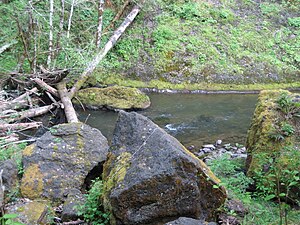| Nestucca River | |
|---|---|
 Nestucca River in the Coast Range | |
| Etymology | Indian word for a part of the river or a point on its banks or for a tribe living nearby[2] |
| Location | |
| Country | United States |
| State | Oregon |
| County | Tillamook |
| Physical characteristics | |
| Source | Central Oregon Coast Range |
| • location | near Ball Bearing Hill, Tillamook County, Oregon |
| • coordinates | 45°16′23″N 123°23′33″W / 45.27306°N 123.39250°W[1] |
| • elevation | 2,249 ft (685 m)[3] |
| Mouth | Nestucca Bay |
• location | near Pacific City, Tillamook County, Oregon |
• coordinates | 45°11′03″N 123°57′26″W / 45.18417°N 123.95722°W[1] |
• elevation | 0 ft (0 m)[1] |
| Length | 57 mi (92 km)[4] |
| Basin size | 255 sq mi (660 km2)[4] |
| Discharge | |
| • average | 1,050 cu ft/s (30 m3/s)[4] |
| Type | Recreational |
| Designated | March 12, 2019[5] |
The Nestucca River flows for about 57 miles (92 km) through forests near the Pacific coast of northwest Oregon in the United States. It drains a timber-producing area of the Northern Oregon Coast Range west of Portland.
Rising in the mountains of western Yamhill County, it is impounded near its headwaters to create McGuire Reservoir, the primary water source for the city of McMinnville. The river flows generally west through Bureau of Land Management (BLM) land and the Siuslaw National Forest, past Beaver, then southwest past Hebo and Cloverdale. It enters Nestucca Bay, on the Pacific Ocean, from the north at Pacific City. The Little Nestucca River does not join the Nestucca but enters Nestucca Bay from the south.
- ^ a b c "Nestucca River". Geographic Names Information System (GNIS). United States Geological Survey. November 28, 1980. Retrieved August 17, 2009.
- ^ McArthur, Lewis A.; McArthur, Lewis L. (2003). Oregon Geographic Names (seventh ed.). Portland, Oregon: Oregon Historical Society Press. pp. 582–83 and 698–99. ISBN 0-87595-277-1.
- ^ Source elevation derived from Google Earth search using GNIS source coordinates.
- ^ a b c Palmer, Tim (2014). Field Guide to Oregon Rivers. Corvallis: Oregon State University Press. pp. 89–91. ISBN 978-0-87071-627-0.
- ^ "Explore Designated Rivers". Rivers.gov. Retrieved January 8, 2022.


